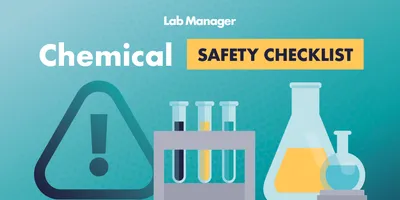Most laboratories, whether clinical, research, or industrial, contain a wide array of chemicals. These chemicals are essential for operations but also pose potential risks to personnel and the environment. A well-structured chemical risk assessment ensures that laboratories maintain a safe working environment while complying with the Occupational Safety and Health Administration (OSHA) regulations and other safety standards. Performing a chemical risk assessment involves several critical steps: evaluating chemicals and reagents, utilizing chemical inventories as a risk assessment tool, and assessing the effectiveness of the laboratory’s chemical hygiene plan (CHP). The use of these assessment tools will help create a safer overall lab environment.
Evaluating chemicals and reagents
The foundation of a strong chemical risk assessment is a thorough evaluation of all chemicals and reagents used in the laboratory. This process involves understanding the hazards associated with each substance and determining the necessary controls to mitigate any accompanying risks. This evaluation can be performed by using a stepwise process.
First, the laboratory should review their chemical safety data sheets (SDS). OSHA’s Hazard Communication Standard (HCS - 29 CFR 1910.1200) mandates that laboratories maintain up-to-date SDSs for all hazardous chemicals. The SDS provides crucial information on:
- Chemical composition and properties
- Potential health hazards
- Storage and handling precautions
- First aid and emergency procedures
- Personal protective equipment (PPE) requirements
Since the United States adopted the Globally Harmonized System for Hazard Communication (GHS) in 2012, chemical manufacturers now generate a standardized, sixteen-section SDS for every hazardous product made. That makes it easier for labs to evaluate these documents in an orderly fashion. Lab personnel should review SDSs regularly to ensure that all staff are familiar with the hazards of the chemicals they work with daily.
Continue the evaluation by identifying hazard categories that apply to each chemical class or category. Chemicals should be categorized based on their primary hazards:
- Flammable (e.g., ethanol, methanol, acetone)
- Corrosive (e.g., hydrochloric acid, sodium hydroxide)
- Reactive (e.g., peroxides, sodium metal)
- Toxic (e.g., formaldehyde, benzene)
- Carcinogenic or mutagenic (e.g., ethidium bromide, acrylamide)
- Reproductive toxins (e.g., mercury, toluene)
Grouping chemicals based on hazards allows the lab to implement appropriate safety measures. These measures can include special handling procedures, designated storage areas, the use of specialized engineering controls (such as chemical fume hoods), and specialized personal protective equipment (PPE).
Next, an assessment of the safe handling procedures for all chemicals used in the laboratory must be completed. Proper handling of chemicals is vital to prevent accidents. Comprehensive chemical procedural risk assessments should evaluate:
- The potential for spills, splashes, or vapor release
- Engineering controls (e.g., fume hoods, ventilation systems)
- Proper transport methods (e.g., secondary containment)
- Compatibility with other substances to avoid dangerous reactions
Once this portion of the chemical risk assessment is completed, the laboratory can establish or modify the CHP to include the safety measures that apply. At this point, specific spill kit types can be purchased and placed in appropriate locations. An analysis of the location of emergency eyewash stations and showers should also occur at this step of the process.
Utilizing chemical inventories as a risk assessment tool
A comprehensive and up-to-date chemical inventory, while required by regulations, also serves as a critical tool in the total risk assessment process. A complete inventory helps the laboratory track chemical quantities and expiration dates. Regular inventory audits help ensure that expired or degraded chemicals, which may become unstable or hazardous, are removed promptly. Inventory management also prevents the overstocking of chemicals, which reduces unnecessary exposure risks.
Lab Safety Management Certificate
The Lab Safety Management certificate is more than training—it’s a professional advantage.
Gain critical skills and IACET-approved CEUs that make a measurable difference.
Chemical inventories are also useful for identifying high-risk chemicals in the lab. By analyzing the chemical inventory, lab managers can pinpoint substances that require additional precautions, such as highly reactive agents or known carcinogens. This enables targeted safety interventions, such as limiting the volume of hazardous chemicals stored onsite or requiring additional training for handling certain substances.
The inventory can also help the laboratory manage chemical storage and segregation. A well-maintained inventory helps enforce proper storage practices by:
- Ensuring flammable chemicals are stored in approved flammable storage cabinets
- Keeping acids and bases in separate, dedicated storage areas near the floor
- Preventing incompatible chemicals from being stored together (e.g., oxidizers away from organic solvents)
- Confirming proper labeling and hazard communication compliance
An effective chemical inventory system, whether paper-based or digital, enables real-time tracking and rapid access to hazard information, making it an invaluable component of laboratory risk assessments.
Evaluating the effectiveness of the laboratory’s CHP
The CHP is the laboratory’s guiding document for chemical safety, and its effectiveness must be evaluated at least annually to ensure it meets OSHA’s requirements and protects lab personnel. There are various methods that can be employed to analyze the plan’s effectiveness:
- Conduct regular laboratory safety audits that include chemical hygiene practices: Routine safety audits help identify gaps in the CHP. Audits should include observations of chemical handling and storage practices, a review of engineering controls (e.g., fume hood functionality tests), and an assessment of emergency preparedness, including spill response capabilities.
- Review lab chemical incident and exposure reports: Past incidents provide valuable lessons for improving safety protocols. Reviewing exposure records, near-miss reports, and accident logs can reveal recurring safety concerns that require corrective actions.
- Deliver training on chemical safety: A CHP effectiveness assessment should evaluate whether staff receive initial training on the plan and chemical handling procedures. Ongoing education should include annual refresher courses on hazard communication as well as hands-on spill response and emergency procedures training. Spill drills should also be routinely performed to ensure staff readiness for a chemical release incident. A successful training program ensures that lab personnel understand the risks associated with their work and know how to mitigate them.
- Evaluate PPE compliance to assess effectiveness: Personal protective equipment is the last line of defense against chemical hazards. Check for the availability and proper use of gloves, lab coats, goggles or face shields, and respirators. Gauge the appropriateness of PPE used for specific chemical hazards (e.g., selecting chemical-proof gloves for solvent use), and ensure the maintenance and replacement schedules for PPE used in the lab.
Keeping chemical safety a priority
The laboratory is a dynamic environment. Processes and instrumentation change often, and the chemicals in use will not remain static. Therefore, a chemical risk assessment cannot be a one-time event; it’s an ongoing process that requires vigilance, training, and adaptation. By systematically evaluating chemical hazards, maintaining an accurate chemical inventory, and regularly reviewing the effectiveness of the CHP, laboratories can foster a culture of safety and compliance.
When was the last time your lab performed a full chemical risk assessment? If it’s been a while, now is the perfect time to start. Safe chemical management isn’t just about compliance—it’s about protecting the health and well-being of every person working in the lab. Stay proactive, stay informed, and stay safe!












